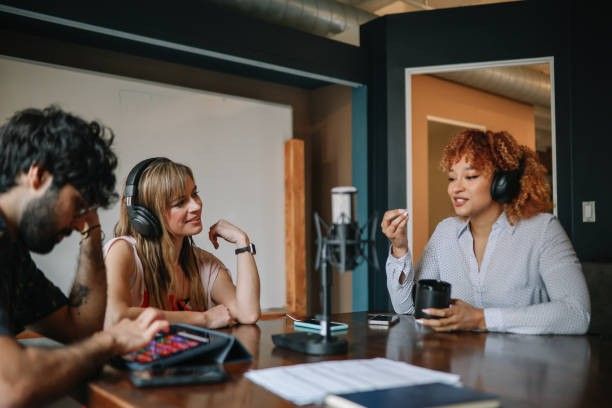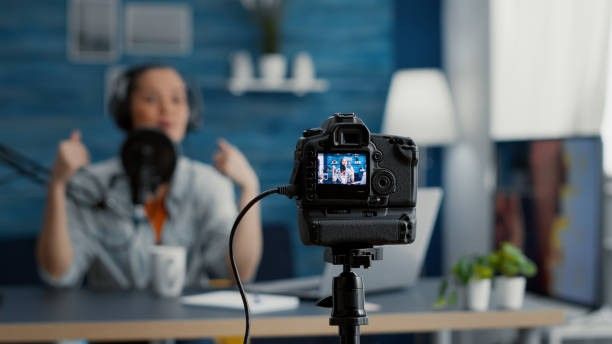Short for "vodcast studio," a vodcast is digital material combining audio and video. Unlike conventional podcasts, which are audio-only, vodcasts incorporate visual components, including on-screen hosts, animations, or demos. See it as a podcast with a face. Sharing podcasts on sites like YouTube, Spotify, and social media makes them a flexible format for producers.
How Vodcasts Work
Podcasts are produced by simultaneously recording audio and video. After editing, the material is posted to video-sharing sites, often with images like text overlays or graphics. Like they would a YouTube video or Netflix episode, viewers may watch podcasts on their devices.
Examples of Popular Vodcasts
Among the well-known vodcasts are TED Talks, Hot Ones, and The Joe Rogan Experience (which frequently has video iterations of the podcast). These productions are more interesting and shareable since they use video to improve the narrative.
What Is the Difference Between a Podcast and a Vodcast?
Having discussed what a podcast is, let's now look at how it differs from one another (vodcast vs podcast). Although all forms have commonalities, they serve different audiences and need different methods of creation and distribution.
Audio vs. Video – The Core Distinction
A podcast and a vodcast differ mostly in their format. Vodcasts incorporate video, while podcasts are audio-only. This difference influences audience participation as well as production. A vodcast studio, for instance, needs cameras, lighting, and video editing tools, while a podcast setup might just call for a microphone and audio editing skills.
Audience Engagement: Visual vs. Audio-Only Experience
Vodcasts blend images with voice, therefore providing a more immersive experience. This can help the material to be more interesting, particularly for subjects that call for demonstrations or face expressions. Conversely, podcasts are more easily available for those who like to multitask—that is, for commuters or gym goers.
Equipment Needed: Vodcast Studio vs. Podcast Setup
Starting a vodcast studio calls for more gear than a podcast. For example, you’ll need a high-quality camera like the NearStream VM20 or the NearStream VM33, a reliable microphone like the NearStream AM20X, and proper lighting. Podcasts, on the other hand, can be recorded with just a USB microphone like the NearStream AM15X.
Platforms for Hosting: Where to Publish Podcasts vs. Vodcasts
Usually hosted on audio services like Apple Podcasts, Spotify, and Google Podcasts, podcasts are Still sometimes posted on YouTube, Vimeo, or even social media sites like Instagram and TikHub.
Which One Is Better for You? Choosing the Right Format
Your objectives and tools will determine whether you choose a podcast or a podcast. A podcast can be the answer if you want a simpler arrangement or are on a budget. A vodcast is the best option, though, if you wish to produce visually appealing material and use video channels.
Podcast vs. Vodcast – Pros and Cons

Every format has advantages and shortcomings. Knowing the advantages and drawbacks of podcasts and vodcasts will help you choose which one best fits your resources and creative vision.
Advantages of Podcasts
Because they require less editing and technology, podcasts are simpler to create. They are also more easily available for listeners, who can tune in while driving, working, or working out. Also, because they are less expensive to set up, podcasts are perfect for novices.
Advantages of Vodcasts
Because they mix audio and visual, podcasts provide more involvement. They are also excellent for branding and sponsorship possibilities since images help make adverts more powerful. Moreover, podcasts are more shareable on social media, enabling a larger audience.
Challenges of Each Format
While vodcasts demand more time, effort, and tools to create, podcasts often find difficulty standing out in a competitive market. Both mediums call for constant material production to develop and keep an audience.
How to Create a Vodcast – Step-by-Step Guide
About to launch your own vodcast? From organizing your material to advertising your program, this detailed guide will help you get going.
Step 1 – Plan Your Vodcast
Start by stating your target demographic and niche. Plan your programs on subjects your viewers find meaningful. Create a content calendar to keep content consistent and orderly.
Step 2 – Set Up Your Vodcast Studio
Invest in quality equipment like the NearStream VM20 for crisp video and the NearStream AM20X for clear audio. Use softbox or ring lights to ensure proper lighting, and choose a clean, clutter-free background.
Step 3 – Record & Edit Your Vodcast
Invest in high-quality tools for crisp video, like the NearStream VM20, and for clear audio, like the NearStream AM20X. Choose a neat, clutter-free background and use softbox lights or ring lights to provide correct illumination.
Step 3 – Record & Edit Your Vodcast
Track your vodcast on a computer with OBS or Streamlabs. Edit your movie with Adobe Premiere Pro or Final Cut Pro to add overlays, transitions, and images.
Step 4 – Publish & Distribute Your Vodcast
Share your video on sites such as YouTube, Spotify, and Vimeo. Perfect your titles, descriptions, and thumbnails to draw viewers.
Step 5 – Promote Your Vodcast for Maximum Reach
To expand your channel, post your vodcast on social media, team up with other producers, and interact with your viewers.
Podcast & Vodcast Monetization – Making Money with Your Show

While producing material is one thing, monetizing it is another. Let's look at how to make your podcast or vodcast an income-generating tool.
Sponsorships & Brand Collaborations
Brand collaboration is one of the most often used strategies to profit from your podcast or vodcast. Product placements, shoutouts, or even special episodes where you evaluate a good or service can all be included in sponsorships. The secret is to work with companies whose products and audience fit your own. For instance, if your vodcast is about fitness, working with a sportswear business or a supplement company might be rather appropriate. Sponsorships provide your show legitimacy in addition to cash help.
YouTube Monetization for Vodcasters
You can leverage several income sources if you post your vodcast on YouTube. Once you satisfy YouTube's eligibility criteria—1,000 subscribers and 4,000 watch hours—you can make money via memberships, advertisements, and Super Chats. While memberships let your viewers directly support you in return for exclusive benefits like behind-the-scenes content or early access to episodes, ads are the most direct approach to making money. Conversely, Super Chats allow viewers pay to emphasize their words during live feeds.
Podcast & Vodcast Subscription Models
Another great approach to creating steady income is subscription models. Platforms like Patreon and Substack let your most devoted followers access special materials or ad-free episodes. You could offer subscribers access to a private community, extra episodes, or longer interviews. This approach performs especially nicely if you have a close relationship with your audience and they are ready to pay for more value.
Selling Digital Products or Services
Additionally, your podcast or vodcast is a venue for marketing and sales of digital goods or services. For example, you might market nutrition recommendations or exercise programs if you are a fitness podcaster. You might provide consultancy services or web courses if your show is on business. One advantage of digital products is their scalability; once developed, they can offer a passive income with little constant work. Also, branded T-shirts, mugs, or stickers might be a great approach to involve your audience and make money.
Future of Vodcasts – Why Video Podcasting Is Growing
Content generation is an ever-changing field. Let's investigate the reasons vodcasts are becoming popular and the direction this style might take.
The Rise of Video Content in Podcasting
With sites like YouTube and Spotify significantly investing in video podcasts, video material is growingly appealing.
How Platforms Like YouTube & Spotify Are Supporting Vodcasts
Today, YouTube and Spotify include tools for vodcasters, such as video uploads, statistics, and monetizing choices.
Predictions for the Future of Audio-Visual Content
With augmented reality and live broadcasting, vodcasts should become even more participatory as technology develops.
Vodcast FAQs – Common Questions Answered

Which platform best suits Vodcasts?
With its vast audience and monetizing choices, YouTube is the most often used vodcast platform.
Can I Turn My Podcast Into a Vodcast?
Yes, you can add video to your existing podcast by recording your sessions with a camera like the NearStream VM20.
Do I Need a Professional Studio to Start a Vodcast?
No, you can start with basic equipment like the NearStream AM15X and a smartphone camera.
Is a Vodcast More Effective Than a Podcast?
It depends on your audience and goals. Vodcasts are more engaging, but podcasts are easier to produce and consume.
Conclusion – Should You Start a Vodcast or a Podcast?
Select a podcast if you want a low-cost, basic setup that just requires audio recording.
- Your readership likes audio-only material.
- You are emphasizing nonvisual narratives, interviews, or debates.
- If you prefer more visual interaction, use a Vodcast.
- You wish to expand your brand using video platforms.
- You have access to video recording equipment like the NearStream VM33.
Final Thoughts – Making the Right Choice
The secret is to provide material that appeals to your listeners, whether you decide on a podcast or a vodcast. You may create an outstanding show that distinguishes itself on the digital scene with the correct tools and approach. Ready to start your vodcast journey? Check out the NearStream vodcast kit for all your streaming needs!






































































